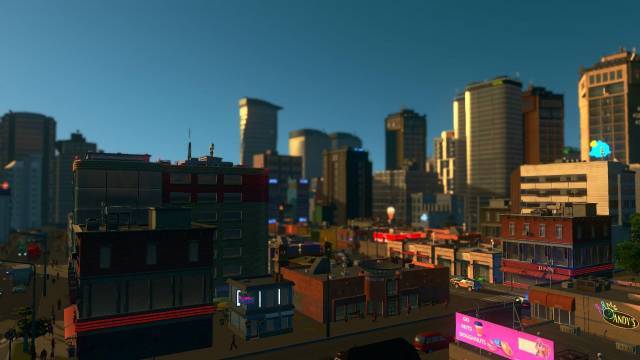Around the road circuit you can develop the three classic building areas: residential, commercial and industrial. At first, only low population density areas are available, which turn into terraced cottages, small farms and modest factories. With time, or unlocking some “milestones” linked to the growing number of inhabitants, populated areas will also be available, which will become skyscrapers, larger business facilities and offices, and expanded industries respectively.
The game’s routines are therefore tied to expansion but, of course, to resource management as well. Electricity and drinking water in the first place, the first to produce (even ecologically, albeit with lesser emission of KW), the second to extract and purify. From this passage I take the lead in pointing out how the Paradox simulator is attentive to details in an almost maniacal way. As for the filtering of drinking water, for example, you have to pay attention to the water flow because, as it is easy to guess, placing the drain before the pump means entering the city into polluted water.
The same demands of citizens are varied and unproductive. It happens to have to deal with one or more houses that are insufficiently accessible by the services, so it will be necessary to strengthen public facilities, or simply improve the road to allow ambulances, firefighters and so on to be able to reach the entire city. The same demand for housing areas has to be kept under control, with a self-feeding system: citizens need work, the factories that are going to work, commercial businesses need factories producing the products they sell, but also skilled workers in the case of offices, which in turn require higher education institutions. There are so many things to consider in a game of Cities: Skylines, so many necessities faithfully reproduced with mechanisms that are quite similar to reality, such as noise pollution among the many. In this case you will need to adopt policies to avoid noises during the day, such as blocking a neighborhood (the city can be divided into areas at will) to traffic, or converting it directly to the historic center.
Among the many policies there is also the possibility of legalizing light drugs, increasing revenue from taxes and tourism. Always with regard to tourism, it will be good to push the creation of receptive structures (always activating one of the policies in the game) near the entrances to the city, thus welcoming tourists in the best way.Pollution, traffic (whose management system is great), health and education coverage, housing value, the ability to claim loans, these and many others are the elements to be considered while playing.
Cities: Skylinesnever bored, it offers the player always something to do or to control. That’s why we do not have a well-structured tutorial. At all times the game offers a good guide to everything by pressing the right analogy, but the player is curious and going to find out all the opportunities.
Given the amount of content to be considered, it would have been even more enjoyable to be accompanied in the game with sweetness. In addition, even in the PlayStation 4 version is completely absent the localization in Italian, which could be an obstacle for those who are hard to read in English. Parlor Mayor Paradox, rather than reviewing the interface, has decided to bring weight to the Cities: Skylines experience
on consoles, simply adapting it to the controller. The screen elements are always clear and intuitive, and you hardly lose information, except in the first game sessions. Once confident with zooming and moving the camera, the only problem worthy of note is the precision of the movements, obviously unreachable with respect to the mouse. The pointer is also used on the PlayStation 4, but it also facilitates the movement of the pointer on some points in the vicinity.
Consequently, when drawing hands free, it takes a lot of patience. Roads, bus lines and residential areas definition, all of which can not be done with the due elegance and often come out of the proverbial green lines.
Patience apart, porting is perfect at the level of controls. Graphically, the game on PC was already very scalable, and for this reason it runs without major problems even on the Sony console. By zooming in the streets of the city the fluidity decreases considerably, while moving away from the bird the problem disappears. Likewise, in order to ensure the framing of frames, scenarios suffer from spontaneous pop-ups, with textures loading at the last and elements that suddenly appear. Nothing dramatic, anyway.

